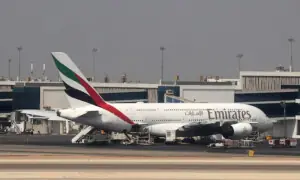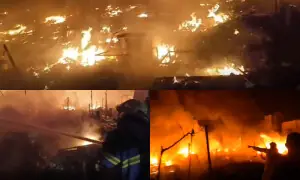North Korea says it tried new fuel in satellite launch that ended in fiery explosion
North Korea’s latest satellite launch exploded in a fireball before dropping into the Yellow Sea just minutes after lifting off, but analysts say the attempt showcased new strides in the nuclear-armed country’s race for space.
North Korea said, opens new tab its latest attempt to launch a military reconnaissance satellite failed in flight on Monday during the rocket’s first stage, which featured a new “liquid oxygen and petroleum engine”.
An initial analysis suggested that the cause of the failure involved the newly developed liquid-fuel rocket motor, but other possible causes were being investigated, a report carried by state media KCNA said.
Although state media did not name the rocket or release photos, analysts said it was most likely different from the Chollima-1 rocket used in the successful satellite launch in November 2023. The Chollima-1, which also suffered several explosive test failures, uses hypergolic fuels, substances that can be stored at room temperature but ignite on contact each other, requiring careful handling.
U.S. officials and independent analysts said the Chollima-1 appeared to be based on systems developed for North Korea’s nuclear-tipped intercontinental ballistic missiles, which typically do not use liquid oxygen because of frigid temperatures required for storage.
A petroleum fuel and liquid oxygen engine may suggest that Russia, which vowed last year to help North Korea’s satellite programme, may have provided assistance, said Lee Choon-geun, an honorary research fellow at South Korea’s Science and Technology Policy Institute.
“Even if it failed, it is a huge leap,” he said, noting that some of South Korea’s space rockets were initially developed with Russia decades ago and use similar technology. “Russia is the strongest country for liquid oxygen-kerosene fuel, and our Naro and Nuri rockets have adopted it through technical cooperation with Russia.”
Liquid oxygen boils at -183°C (–297°F), and requires specialised fuel storage and other equipment, Lee said. That may account for why North Korea conducted multiple static rocket tests late last year, he added.
“It is quite difficult to solve combustion instability problems of this fuel system and apply materials and parts that can withstand extremely low temperatures,” Lee said.
Some analysts questioned why North Korea would switch engine types, but Lee said it could allow Pyongyang to separate its civilian space program from the ballistic missiles banned by the United Nations Security Council.
Russian experts have visited North Korea to help with the satellite and space rocket program, Yonhap news agency reported, citing an unnamed South Korean senior defence official.
Neither Moscow nor Pyongyang have detailed what aid is being provided.
Shin Jong-woo, a senior researcher at the Korea Defense and Security Forum, said that if Russia helped design the new rocket or satellite, North Korea would also most likely need Russian components well into the future, deepening the cooperation.
“North Koreans can re-launch soon if they obtain and analyse data correctly for that two-minute flight,” Shin said.
South Korea’s military, however, said it could take North Korea sometime before it can try to launch again.
South Korea released video footage on Tuesday that its military said showed the moment the launch ended in failure.
The one-minute black-and-white video provided by the South’s Joint Chiefs of Staff (JCS) showed what appeared to be an explosion in the sky followed by flashes.
The footage was filmed by an observation device on a South Korean patrol vessel, the JCS said.
Footage released on Monday by Japanese broadcaster NHK, filmed from the Chinese border city of Dandong, showed a similar ball of flame that officials said was probably exploding fuel.
Nuclear envoys of South Korea, the United States and Japan had a phone call on Tuesday and strongly condemned the launch as a direct violation of the U.N. Security Council resolutions banning the North’s use of ballistic missile technology, Seoul’s foreign ministry said.
The launch came hours after China, South Korea, and Japan wrapped up a rare three-way summit in Seoul.
Read more
For the latest news, follow us on Twitter @Aaj_Urdu. We are also on Facebook, Instagram and YouTube.





















Comments are closed on this story.